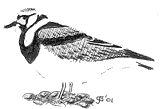|
Back to
Newsletter
Systematic list -
Red-throated Diver to
Shag.
Bittern to Brent Goose.
Shelduck to Common
Scoter.
Velvet Scoter to
Osprey.
Merlin to Grey Plover.
Lapwing to Bar-tailed
Godwit.
Whimbrel to Great Skua (below).
Mediterranean Gull to Reed Bunting will be
published in the July 2002 Newsletter.
Whimbrel
Numenius phaeopus
Passage
First recorded :- 2 April 8th.
Peak count for year :- 9 April 23rd.
First returning birds :- 2 July 18th.
Last recorded :- 1 September 19th.
[ The amount of disturbance this spring, due to the Foot and Mouth
outbreak, had a severe effect on migrants utilising the wardening area. This
was shown by the difference between the Whimbrel figures for West Kirby /
Red Rocks and those reported from Hoylake shore, a far less heavily
frequented stretch of beach. There were 31 individual Whimbrel recorded over
both passage periods this year. ]
Eurasian Curlew
N. arquata Resident.
More common in winter
Peak monthly counts :-
No systematic counts were made outside the Wardening period
|
Jan |
Feb |
Mar |
Sept |
Oct |
Nov |
Dec |
| 260 |
80 |
56 |
(375) |
500 |
230 |
210 |
[Numbers of Curlew using the roost were extremely low in the first winter
period. This may have been due to the ground conditions inland as on most
days numbers were seen flighting onto Hoylake Langfields. Counts on the
estuary are rising and the Internationally Important numbers recorded place
the Dee in third place in Britain.]
Common Redshank
Tringa totanus
Resident. More common in winter
Peak monthly counts :-
No systematic counts were made outside the Wardening period
|
Jan |
Feb |
Mar |
Sept |
Oct |
Nov |
Dec |
| 300 |
400 |
700 |
(46) |
150 |
375 |
500 |
[ Redshank are usually considered to be a flighty wader but they are the
last to leave the roost site during very high tides and remain in the
saltmarsh throughout the lower ones despite the dogs etc. This is another
species to show a consistent decline throughout the estuary over the last
decade even though the Dee is still the second most Internationally
Important site in Britain.]
Common Greenshank
T. nebularia
Rare passage
2 Red Rocks August 8th, 2 in flight August 18th. 3 in flight August 21st.
[ A common passage migrant in autumn higher up the estuary and a scarce
winterer, Greenshank are probably kept from being more regular on site by
ecology more than disturbance. ]
Green Sandpiper
T. ochropus
Vagrant
Singles August 21st., September 3rd.
[ Although the dune slack and Natterjack enclosures are ideal habitat for
smaller waders the amount of disturbance probably prevents this from
occurring more often. These were the first records for the wardens ]
Common Sandpiper
Actitis hypoleucos
Vagrant
Singles April 16th, July 16th.
[These two records are possibly only the 12th and 13th from the site, and
most of the others concern overflying birds. Up to 3 birds at a time were
reported by ringers as being present on Hoylake shore at night during
August.]
Ruddy Turnstone
Arenaria interpres
Scarce resident
Monthly maximum on Marine Lake :-
| Jan |
Feb |
Mar |
Apr |
May |
June |
July |
Aug |
Sept |
Oct |
Nov |
Dec |
| 41 |
11 |
29 |
37 |
5 |
n/c |
3 |
9 |
11 |
27 |
49 |
100 |

[The small flock of roosting Turnstone still occurs on the rock arbour at
the site of the old baths but, more and more, people are climbing through
the fence to sit on the rocks over the tide, even in the middle of winter.
Another species that is found in Internationally Important numbers on the
estuary.]
Arctic Skua
Stercorarius parasiticus
Vagrant
2 May 1st, 1 July 20th., 1August 18th., 3 September 1st., 2 September
3rd., 3 September 21st., 1 October 7th. All between Red Rocks and Hilbre. 1
on West Kirby beach September 16th.
[Although both Arctic and Great Skua have been recorded off Red Rocks by
the wardens in previous autumns the birds in May were our first spring
records for this species. Many other Arctic Skua were seen off the north end
of Hilbre but are not included in the reporting area.]
Long-tailed Skua
S. longicaudatus
County Rarity
1 dark phase juvenile on West Kirby shore September 16th. ( CB, D and K
L, RF. )
[Long-tailed Skua are the scarcest of the accepted species of skua to
pass through British waters and this bird on the beach was the first record,
for the wardens, actually inside the mouth of the estuary. The sight of this
bird struggling against the wind a few yards from the watchers and looking
like a giant Leach’s Storm-Petrel, less than 30 minutes after an Arctic
Skua, and on the first day of the second period of wardening, was
incredible. Awaiting confirmation from CAWOS Rarities Committee.]
Great Skua
Catharacta skua
Vagrant
1 April 7th, May 3rd, 1 August 28th., 2 August 29th. 2 September 21st.
All off Red Rocks
[ As stated above spring records of Skua have not been previously
recorded by the wardens so the appearance of two species in spring was quite
stirring. Great Skua is the only species we have recorded inside the mouth
of the estuary, until this year, the last being seen flying upriver in
1997.]
Back to newsletter.
Red-throated Diver to
Shag.
Bittern to Brent Goose.
Shelduck to Common
Scoter.
Velvet Scoter to
Osprey.
Merlin to Grey Plover.
Lapwing to Bar-tailed
Godwit.
Mediterranean Gull to Reed Bunting will be
published in the July 2002 Newsletter.
| 